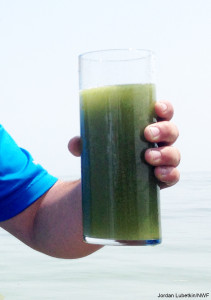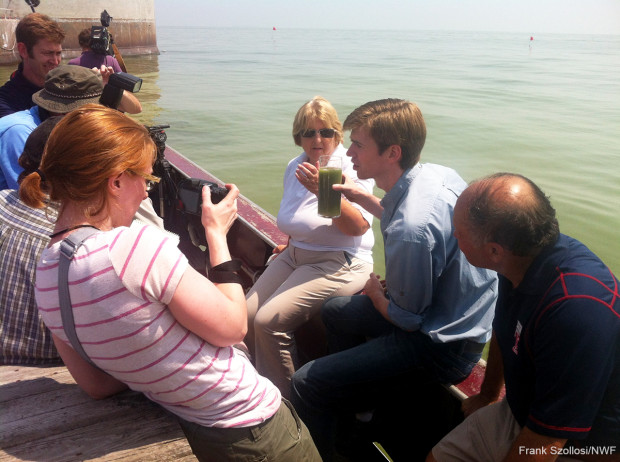We have much more to do and your continued support is needed now more than ever.
Toxic Algal Bloom Threatens Wildlife and Shuts Down Drinking Water to Toledo

Early Saturday morning I was abruptly woken up by a neighbor knocking on the door. He actually then opened a window, saying “Don’t drink the water! Don’t let the kids drink the water!”
My first thought was algal blooms, as already this summer, these blooms were growing in Western Lake Erie. Last September, Carroll Township in Ohio had to shut down their water system for four days because of algal blooms. Now it was happening to my town, Toledo.
I looked online, and, sure enough, the local newspaper had a flash at 2 a.m. that the City of Toledo issued a warning of microcystin in the water. Microcystin is the worst product of an algal bloom—it’s a toxin that induces vomiting, diarrhea and liver damage. An incident down in Brazil with contaminated water killed 75 people.
Algal Blooms and Wildlife
National Wildlife Federation has been engaged in this issue for years. Not only can algal blooms contaminate drinking water supplies (this one left 500,000 people in the Toledo area without clean water), but it causes major damage to ecosystems.
The problem for wildlife isn’t so much the toxin (which is still harmful) as the algae itself. The threat comes from hypoxia of water, as algae die and then consume oxygen during decomposition, oxygen which is needed by fish to survive. That drives fish elsewhere, adds to their stress and disrupts reproduction.
In addition, birds (and especially waterfowl) are susceptible to the microcystin. High levels in Lake Erie might lead to liver lesions, and similar blooms in the Chesapeake Bay and Gulf of California were linked to the deaths of great blue herons and California brown pelicans.
The City of Toledo draws its water from an intake structure 2 miles out in Lake Erie, which unfortunately is centered right in the heart of the algal bloom. Wind and current had bulls-eyed the algal bloom right at the intake out in the Western Basin.
Surveying the Damage
National Wildlife Federation President and CEO Collin O’Mara traveled with reporters on a boat tour to the intake site yesterday. He said the situation is part of a larger issue:
“There’s a systematic challenge we face here in the Great Lakes region that’s much bigger than the current water crisis in Toledo,” Mr. O’Mara said, referring to climate change and how scientists believe it has exacerbated algae blooms in recent years. “If we don’t get our arms around it, we will see property values decline, tourism decline, and wildlife impacted, too. I encourage everyone to consider the broader issues.”

A Long-Term Problem
Algal blooms happen because of farming practices, how we put our fertilizer on our lawns, stormwater runoff and discharge from municipal wastewater systems. Toledo also feels the impact of Detroit pumping their wastewater into Lake Erie up-current from our shores. All these things exacerbated something that, fundamentally, has been going on for a few years now.
Add to this, climate change, which is the threat multiplier for all those vectors, fueling extreme weather events. The Great Lakes region is experiencing much more frequent and extreme precipitation events. The largest watershed in the Great Lakes has had a 37 percent increase in heavy precipitation, and more rainfall and snow is pushing nutrients and pollution into streams and into Lake Erie.
This event happened in the middle of the night, but it didn’t happen overnight. The lake is reaching a tipping point from all this phosphorous and pollutants. The water is getting warmer and more polluted, and threatening wildlife and habitat.





















